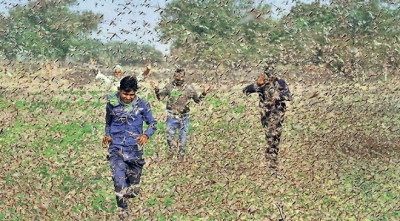
Locusts are solitary insects. They are related to grasshoppers, they look and behave like them. But locusts have another behavioural phase called the gregarious phase, which is when they turn out to be a nightmare for farmers. The desert locust is the most destructive of all food-eating locust species because of its speed and ability to multiply rapidly. The recent outbreak in India is believed to be among the worst. Crops in more than 3.5 lakh hectares in various districts of Rajasthan and Gujarat were damaged. Thanks to a number of timely measures and a change in wind direction, a larger damage was averted. But Eastern Africa is experiencing the worst outbreak of the desert locust in 70 years and the U.N. has sought $70 million from international donors to scale up control measures.
Two phased locusts
- Locusts are a group of short-horned grasshoppers that belong to the family called Acrididae. The main difference between grasshoppers and locusts is that the latter can exist in two different behavioural states – solitary and gregarious (gregarious; Become social and live in groups/herds/flocks/swarms). When the population density is high, individuals undergo physiological and behavioural changes. They form bands of nymphs (hoppers or young ones) or swarms of adults and congregate into thick, mobile, ravenous swarms.
- In the case of the desert locust, the solitary brown adults become pink in the gregarious phase, while the immature ones become yellow. These changes are so dramatic that the swarming and non-swarming forms were once considered to be different species.
- The locusts travel long distances in swarms, multiply in numbers as they migrate and devour vegetation wherever they settle. They eat leaves, flowers, fruits, seeds and bark, and also destroy plants by their sheer weight as they descend on them in massive numbers.
Picture Credit : Google




